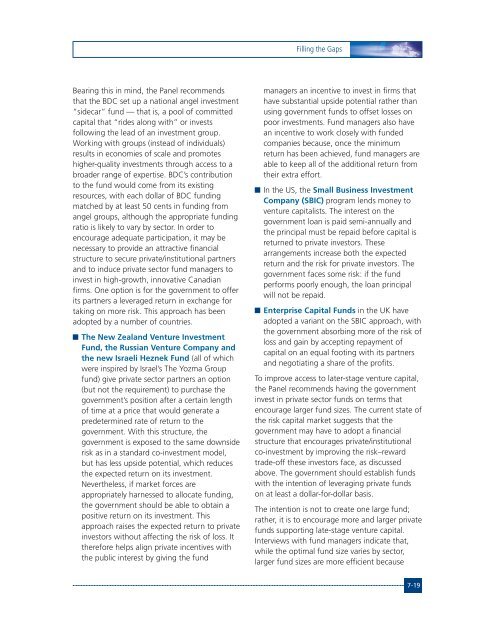Innovation Canada: A Call to Action
Innovation Canada: A Call to Action
Innovation Canada: A Call to Action
You also want an ePaper? Increase the reach of your titles
YUMPU automatically turns print PDFs into web optimized ePapers that Google loves.
Filling the GapsBearing this in mind, the Panel recommendsthat the BDC set up a national angel investment“sidecar” fund — that is, a pool of committedcapital that “rides along with” or investsfollowing the lead of an investment group.Working with groups (instead of individuals)results in economies of scale and promoteshigher-quality investments through access <strong>to</strong> abroader range of expertise. BDC’s contribution<strong>to</strong> the fund would come from its existingresources, with each dollar of BDC fundingmatched by at least 50 cents in funding fromangel groups, although the appropriate fundingratio is likely <strong>to</strong> vary by sec<strong>to</strong>r. In order <strong>to</strong>encourage adequate participation, it may benecessary <strong>to</strong> provide an attractive financialstructure <strong>to</strong> secure private/institutional partnersand <strong>to</strong> induce private sec<strong>to</strong>r fund managers <strong>to</strong>invest in high-growth, innovative Canadianfirms. One option is for the government <strong>to</strong> offerits partners a leveraged return in exchange fortaking on more risk. This approach has beenadopted by a number of countries.The New Zealand Venture InvestmentFund, the Russian Venture Company andthe new Israeli Heznek Fund (all of whichwere inspired by Israel’s The Yozma Groupfund) give private sec<strong>to</strong>r partners an option(but not the requirement) <strong>to</strong> purchase thegovernment’s position after a certain lengthof time at a price that would generate apredetermined rate of return <strong>to</strong> thegovernment. With this structure, thegovernment is exposed <strong>to</strong> the same downsiderisk as in a standard co-investment model,but has less upside potential, which reducesthe expected return on its investment.Nevertheless, if market forces areappropriately harnessed <strong>to</strong> allocate funding,the government should be able <strong>to</strong> obtain apositive return on its investment. Thisapproach raises the expected return <strong>to</strong> privateinves<strong>to</strong>rs without affecting the risk of loss. Ittherefore helps align private incentives withthe public interest by giving the fundmanagers an incentive <strong>to</strong> invest in firms thathave substantial upside potential rather thanusing government funds <strong>to</strong> offset losses onpoor investments. Fund managers also havean incentive <strong>to</strong> work closely with fundedcompanies because, once the minimumreturn has been achieved, fund managers areable <strong>to</strong> keep all of the additional return fromtheir extra effort.In the US, the Small Business InvestmentCompany (SBIC) program lends money <strong>to</strong>venture capitalists. The interest on thegovernment loan is paid semi-annually andthe principal must be repaid before capital isreturned <strong>to</strong> private inves<strong>to</strong>rs. Thesearrangements increase both the expectedreturn and the risk for private inves<strong>to</strong>rs. Thegovernment faces some risk: if the fundperforms poorly enough, the loan principalwill not be repaid.Enterprise Capital Funds in the UK haveadopted a variant on the SBIC approach, withthe government absorbing more of the risk ofloss and gain by accepting repayment ofcapital on an equal footing with its partnersand negotiating a share of the profits.To improve access <strong>to</strong> later-stage venture capital,the Panel recommends having the governmentinvest in private sec<strong>to</strong>r funds on terms thatencourage larger fund sizes. The current state ofthe risk capital market suggests that thegovernment may have <strong>to</strong> adopt a financialstructure that encourages private/institutionalco-investment by improving the risk–rewardtrade-off these inves<strong>to</strong>rs face, as discussedabove. The government should establish fundswith the intention of leveraging private fundson at least a dollar-for-dollar basis.The intention is not <strong>to</strong> create one large fund;rather, it is <strong>to</strong> encourage more and larger privatefunds supporting late-stage venture capital.Interviews with fund managers indicate that,while the optimal fund size varies by sec<strong>to</strong>r,larger fund sizes are more efficient because7-19
















